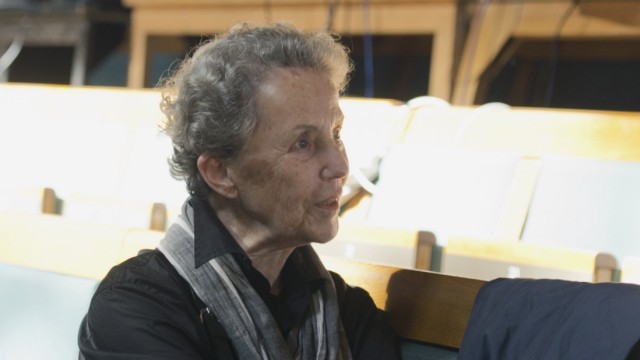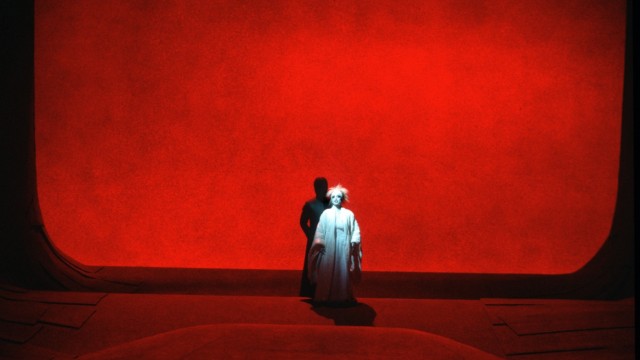He has “The Eye of the Schaubühne”. Daily Mirror she recently mentioned. That was on the occasion of the Walz exhibition in the Berlin Museum of Photography. And because Ruth Walz was closely associated with the Schaubühne for almost thirty years and still lives in the capital today, Berlin is also the natural place to honor the life’s work of the photographer, who was born in 1941. Since the 1990s until today, the images of the now over eighty-year-olds have been an integral part of the Salzburg Festival summer. The second Walz solo exhibition has just been dismantled. The fact that the German Theater Museum in Munich has now followed suit points to the national importance of this photographer.
The work of set designer Karl-Ernst Herrmann is also highlighted in the photo exhibition.
(Photo: Ruth Walz)

At the Berlin Schaubühne, costume designer Moidele Bickel and set designer Karl-Ernst Herrmann were involved in around 30 productions together.
(Photo: Ruth Walz)
Unique selling point of the theater picture homage “Double Exposure” curated by Hanns Zischler and Thomas Ladenburger in collaboration with Walz himself: It also takes a look at the work of the set designer Karl-Ernst Herrmann and the costume designer Moidele Bickel, who worked during the golden Schaubühne years were involved in around 30 productions together between 1970 and 1989.
In addition, “Double Exposure” flanks photos of Walz with those of her colleague Abisag Tüllmann. They both photographed Deborah Warner’s 1993 Salzburg production of Shakespeare’s “Coriolanus.” Tüllmann a wide shot, Walz a close-up. In the exhibition they hang opposite each other as if to show that two people share the same passion but have opposing perspectives. Occasionally the two women shared a darkroom and got into friendly arguments there. The exhibition features a walk-in replica of this chamber, with four developer trays instead of the usual three, with slide projectors hanging above them.
Rapidly changing slides show important people from West German theater history in the 1970s and 1980s: Peter Stein, of course, who directed the Berlin Schaubühne from 1970 onwards, Luc Bondy and Klaus Michael Grüber, actors and actresses such as Edith Clever, Therese Giehse and Bruno Ganz, with the Walz was in a relationship for decades. The slides mainly show backstage and rehearsal situations – because the “theater photo director” (Gerhard Stadelmaier) Ruth Walz always accompanied every theater event from the beginning.
Beyond the darkroom, there is much evidence that theater photographers have the power to interpret what survives in the collective memory of the fleeting nature of the stage. There is particularly a lot of space for Robert Wilson’s production of Virginia Woolf’s “Orlando”, which the US director created with Jutta Lampe in 1989 and recreated one-on-one with Isabelle Huppert in 1993. Walz’s earlier work captured architecturally austere images that emphasized the delicacy of the human body. Abisag Tüllmann’s later performance appears in a softer light.
Short texts provide information about the special challenges of theater photography as well as individual productions – often with vivid quotes from directors or critics. This means everyone can find their own access to the diverse exhibits. Here a darkly humorous letter from Tüllmann, there delicate watercolor drawings by Moidele Bickel, not far from there a wall with photos of Karl-Ernst Herrmann at almost all ages. And the Schaubühne period, which is the focus of the exhibition, is anything but homogeneous. Stein’s “Oresteia” can be accompanied on some of its journeys; partially trace the development of his detailed magical realism. It’s great how Corinna Kirchhoff provides information in an audio about the function of a humming top in Stein’s iconic “Three Sisters” production.

Photos from a wide variety of “Macbeth” productions can also be seen at the “Double Exposure” exhibition. Here is the performance at the Staatsoper Unter den Linden from 2000.
(Photo: Ruth Walz)
The last room, full of photos from a wide variety of “Macbeth” productions, moves closer to the present, from the bombastic crowd scene in the Paris Opera to Johan Simon’s current Bochum version, compressed to three actors. Here it becomes clear once again which aesthetic and historical range is up for assessment and debate. A good piece of theater history.
“Double Exposure”, until February 4, 2024 in the German Theater Museum Munich, Galeriestrasse

